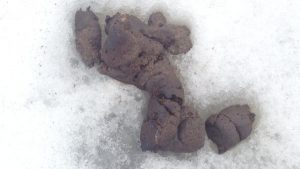A seasonal scourge prompts dog groomer Anne Dopson to tackle the neighbourhoods of Terrace, B.C. with a shovel at the first signs of melting snow.
 In anticipation of this year’s thaw, Dopson adopted a strict anti-excrement regimen, plastering posters around town and even handing out scoops and garbage bags to her fellow canine lovers.
In anticipation of this year’s thaw, Dopson adopted a strict anti-excrement regimen, plastering posters around town and even handing out scoops and garbage bags to her fellow canine lovers.
But nothing seems to rid Terrace of the smelly brown mess revealed each spring.
“It’s right on the road, the side of the road,” sighed Dopson.
“It’s almost like people just park there, open their doors and let their dogs out to do their business, and then they come back in. It gets on dogs’ paws, on people’s footwear, and they track that home.”
Persistent piles of poop aren’t just an assault on the senses, says Erin Fraser, a public health veterinarian with the B.C. Centre for Disease Control.
“E. coli is often prevalent in dog feces,” which thrives alongside salmonella and assorted parasites, she told CBC Radio’s Carolina de Ryk.
And the feces itself is everywhere this time of year, Fraser adds. “The volume of dog waste can be staggering, and communities all over Canada struggle with how best to address this issue.”
